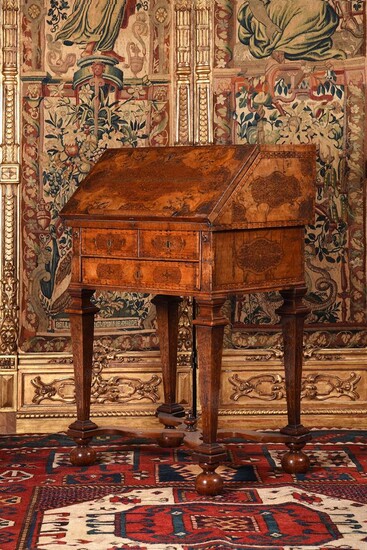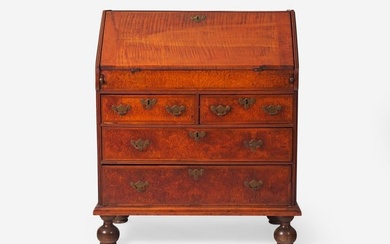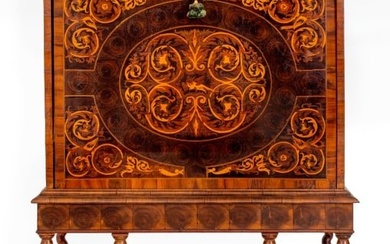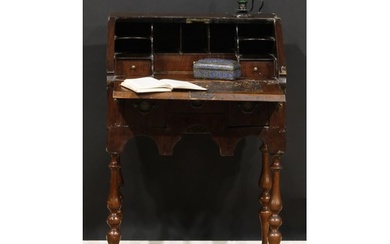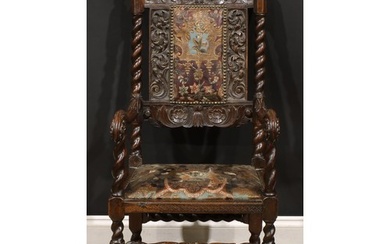A WILLIAM & MARY WALNUT AND 'SEAWEED' MARQUETRY BUREAU POSSIBLY BY GERRIT JENSEN
A WILLIAM & MARY WALNUT AND 'SEAWEED' MARQUETRY BUREAU POSSIBLY BY GERRIT JENSEN, CIRCA 1690The fall opening to an arrangement of small drawers and shelves above a velvet inset writing surface92cm high, 56cm wide, 45cm deep overallProvenance: Private Collection, LondonFor a remarkably closely related bureau see, Christie's, London, English Furniture, 8th July 1999, Lot 35 (£161,000). Born in Holland and trained in Paris before settling in London, Gerrit Jensen (fl. 1667 - d. 1715) was arguably the most important cabinet maker in England during the second half of the 17th century and beginning of the 18th century. Based in Long Acre and St. Martin's Lane, London, his bills are the first to record floral marquetry and his stile was strongly influenced by the French taste of the period, two stylistic qualities seen on the bureau here. Numerous influential noblemen were among his clients and receipts for his furniture are recorded for some of the grandest country houses, including Burghley House (Lincolnshire), Chatsworth (Derbyshire), Arundel Castle (Sussex), Knole (Kent), and Petworth House (Sussex). Most notably, Jensen held the post of cabinet maker in ordinary to to successive monarchs from James II to Queen Anne and had hundreds of items commissioned for the royal residences at Whitehall, St James, Somerset House, Kensington Palace, Windsor Castle and Hampton court. Provenance: Exhibited in Bath Assembly Rooms, International Treasures 1973, No.101.Condition Report: Marks, knocks, scratches and abrasions commensurate with age and use. Various old splits, chips and some losses (see images). Polished appearance to timber. Some fading to timbers. Old repairs to veneers (see images for details). Larger split across the front of the fall. Section of the paper rest to the front of the fall has been re-secured. The escutcheon to the fall is lacking. The inset fabric to the interior is later and has wear, fading and losses. Axe head handles to the interior drawers and the lopers are replacements. Locks are 18th century replacements. A key is present and opens all locks. The lock plate to the fall is engraved and is of exceptional quality. A key is present and operates all locks. There are plugged holes to the drawer fronts from where handles previously sat. There are also some areas of filler around the escutcheons where these have been replaced. The legs are original but there is glue residue, thin later blocks and some repaired splits where they meet the main body of the bureau. This suggests they have been re-secured in position. The feet are well matched old replacements. The turned finial to the centre of the stretcher is likely a replacement. Some evidence of old worm. Please refer to additional images for visual reference to condition. Condition Report Disclaimer
[ translate ]View it on
Sale price
Estimate
Time, Location
Auction House
A WILLIAM & MARY WALNUT AND 'SEAWEED' MARQUETRY BUREAU POSSIBLY BY GERRIT JENSEN, CIRCA 1690The fall opening to an arrangement of small drawers and shelves above a velvet inset writing surface92cm high, 56cm wide, 45cm deep overallProvenance: Private Collection, LondonFor a remarkably closely related bureau see, Christie's, London, English Furniture, 8th July 1999, Lot 35 (£161,000). Born in Holland and trained in Paris before settling in London, Gerrit Jensen (fl. 1667 - d. 1715) was arguably the most important cabinet maker in England during the second half of the 17th century and beginning of the 18th century. Based in Long Acre and St. Martin's Lane, London, his bills are the first to record floral marquetry and his stile was strongly influenced by the French taste of the period, two stylistic qualities seen on the bureau here. Numerous influential noblemen were among his clients and receipts for his furniture are recorded for some of the grandest country houses, including Burghley House (Lincolnshire), Chatsworth (Derbyshire), Arundel Castle (Sussex), Knole (Kent), and Petworth House (Sussex). Most notably, Jensen held the post of cabinet maker in ordinary to to successive monarchs from James II to Queen Anne and had hundreds of items commissioned for the royal residences at Whitehall, St James, Somerset House, Kensington Palace, Windsor Castle and Hampton court. Provenance: Exhibited in Bath Assembly Rooms, International Treasures 1973, No.101.Condition Report: Marks, knocks, scratches and abrasions commensurate with age and use. Various old splits, chips and some losses (see images). Polished appearance to timber. Some fading to timbers. Old repairs to veneers (see images for details). Larger split across the front of the fall. Section of the paper rest to the front of the fall has been re-secured. The escutcheon to the fall is lacking. The inset fabric to the interior is later and has wear, fading and losses. Axe head handles to the interior drawers and the lopers are replacements. Locks are 18th century replacements. A key is present and opens all locks. The lock plate to the fall is engraved and is of exceptional quality. A key is present and operates all locks. There are plugged holes to the drawer fronts from where handles previously sat. There are also some areas of filler around the escutcheons where these have been replaced. The legs are original but there is glue residue, thin later blocks and some repaired splits where they meet the main body of the bureau. This suggests they have been re-secured in position. The feet are well matched old replacements. The turned finial to the centre of the stretcher is likely a replacement. Some evidence of old worm. Please refer to additional images for visual reference to condition. Condition Report Disclaimer
[ translate ]